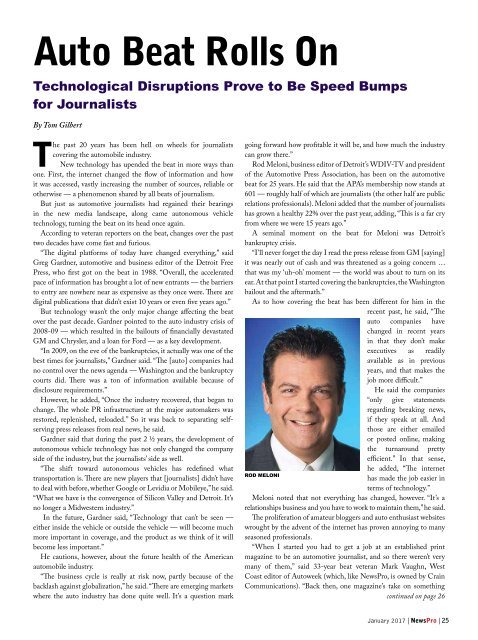12 to Watch
2jsKIWf
2jsKIWf
Create successful ePaper yourself
Turn your PDF publications into a flip-book with our unique Google optimized e-Paper software.
Au<strong>to</strong> Beat Rolls On<br />
Technological Disruptions Prove <strong>to</strong> Be Speed Bumps<br />
for Journalists<br />
By Tom Gilbert<br />
The past 20 years has been hell on wheels for journalists<br />
covering the au<strong>to</strong>mobile industry.<br />
New technology has upended the beat in more ways than<br />
one. First, the internet changed the flow of information and how<br />
it was accessed, vastly increasing the number of sources, reliable or<br />
otherwise — a phenomenon shared by all beats of journalism.<br />
But just as au<strong>to</strong>motive journalists had regained their bearings<br />
in the new media landscape, along came au<strong>to</strong>nomous vehicle<br />
technology, turning the beat on its head once again.<br />
According <strong>to</strong> veteran reporters on the beat, changes over the past<br />
two decades have come fast and furious.<br />
“The digital platforms of <strong>to</strong>day have changed everything,” said<br />
Greg Gardner, au<strong>to</strong>motive and business edi<strong>to</strong>r of the Detroit Free<br />
Press, who first got on the beat in 1988. “Overall, the accelerated<br />
pace of information has brought a lot of new entrants — the barriers<br />
<strong>to</strong> entry are nowhere near as expensive as they once were. There are<br />
digital publications that didn’t exist 10 years or even five years ago.”<br />
But technology wasn’t the only major change affecting the beat<br />
over the past decade. Gardner pointed <strong>to</strong> the au<strong>to</strong> industry crisis of<br />
2008-09 — which resulted in the bailouts of financially devastated<br />
GM and Chrysler, and a loan for Ford — as a key development.<br />
“In 2009, on the eve of the bankruptcies, it actually was one of the<br />
best times for journalists,” Gardner said. “The [au<strong>to</strong>] companies had<br />
no control over the news agenda — Washing<strong>to</strong>n and the bankruptcy<br />
courts did. There was a <strong>to</strong>n of information available because of<br />
disclosure requirements.”<br />
However, he added, “Once the industry recovered, that began <strong>to</strong><br />
change. The whole PR infrastructure at the major au<strong>to</strong>makers was<br />
res<strong>to</strong>red, replenished, reloaded.” So it was back <strong>to</strong> separating selfserving<br />
press releases from real news, he said.<br />
Gardner said that during the past 2 ½ years, the development of<br />
au<strong>to</strong>nomous vehicle technology has not only changed the company<br />
side of the industry, but the journalists’ side as well.<br />
“The shift <strong>to</strong>ward au<strong>to</strong>nomous vehicles has redefined what<br />
transportation is. There are new players that [journalists] didn’t have<br />
<strong>to</strong> deal with before, whether Google or Levidia or Mobileye,” he said.<br />
“What we have is the convergence of Silicon Valley and Detroit. It’s<br />
no longer a Midwestern industry.”<br />
In the future, Gardner said, “Technology that can’t be seen —<br />
either inside the vehicle or outside the vehicle — will become much<br />
more important in coverage, and the product as we think of it will<br />
become less important.”<br />
He cautions, however, about the future health of the American<br />
au<strong>to</strong>mobile industry.<br />
“The business cycle is really at risk now, partly because of the<br />
backlash against globalization,” he said. “There are emerging markets<br />
where the au<strong>to</strong> industry has done quite well. It’s a question mark<br />
going forward how profitable it will be, and how much the industry<br />
can grow there.”<br />
Rod Meloni, business edi<strong>to</strong>r of Detroit’s WDIV-TV and president<br />
of the Au<strong>to</strong>motive Press Association, has been on the au<strong>to</strong>motive<br />
beat for 25 years. He said that the APA’s membership now stands at<br />
601 — roughly half of which are journalists (the other half are public<br />
relations professionals). Meloni added that the number of journalists<br />
has grown a healthy 22% over the past year, adding, “This is a far cry<br />
from where we were 15 years ago.”<br />
A seminal moment on the beat for Meloni was Detroit’s<br />
bankruptcy crisis.<br />
“I’ll never forget the day I read the press release from GM [saying]<br />
it was nearly out of cash and was threatened as a going concern …<br />
that was my ‘uh-oh’ moment — the world was about <strong>to</strong> turn on its<br />
ear. At that point I started covering the bankruptcies, the Washing<strong>to</strong>n<br />
bailout and the aftermath.”<br />
As <strong>to</strong> how covering the beat has been different for him in the<br />
recent past, he said, “The<br />
au<strong>to</strong> companies have<br />
changed in recent years<br />
in that they don’t make<br />
executives as readily<br />
available as in previous<br />
years, and that makes the<br />
job more difficult.”<br />
He said the companies<br />
“only give statements<br />
regarding breaking news,<br />
if they speak at all. And<br />
those are either emailed<br />
or posted online, making<br />
the turnaround pretty<br />
efficient.” In that sense,<br />
he added, “The internet<br />
Rod Meloni<br />
has made the job easier in<br />
terms of technology.”<br />
Meloni noted that not everything has changed, however. “It’s a<br />
relationships business and you have <strong>to</strong> work <strong>to</strong> maintain them,” he said.<br />
The proliferation of amateur bloggers and au<strong>to</strong> enthusiast websites<br />
wrought by the advent of the internet has proven annoying <strong>to</strong> many<br />
seasoned professionals.<br />
“When I started you had <strong>to</strong> get a job at an established print<br />
magazine <strong>to</strong> be an au<strong>to</strong>motive journalist, and so there weren’t very<br />
many of them,” said 33-year beat veteran Mark Vaughn, West<br />
Coast edi<strong>to</strong>r of Au<strong>to</strong>week (which, like NewsPro, is owned by Crain<br />
Communications). “Back then, one magazine’s take on something<br />
continued on page 26<br />
January 2017 | NewsPro | 25


